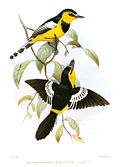Twelve-wired bird-of-paradise
| Twelve-wired bird-of-paradise | |
|---|---|

| |
| Male | |
| Scientific classification | |
| Kingdom: | Animalia |
| Phylum: | Chordata |
| Class: | Aves |
| Order: | Passeriformes |
| Family: | Paradisaeidae |
| Genus: | Seleucidis Lesson, RP, 1834 |
| Species: | S. melanoleucus
|
| Binomial name | |
| Seleucidis melanoleucus (Daudin, 1800)
| |
| Subspecies[2] | |
| |
| Synonyms | |
| |
The twelve-wired bird-of-paradise (Seleucidis melanoleucus) is a medium-sized, approximately 33 cm (13 in) long, velvet black and yellow bird-of-paradise. The male has a red iris, long black bill and rich yellow plumes along his flanks. From the rear of these plumes emerge twelve blackish, wire-like filaments, which bend back near their bases to sweep forward over the bird's hindquarters. The female is a brown bird with black-barred buff underparts. Their feet are strong, large-clawed and pink.
The sole representative of the monotypic genus Seleucidis, the twelve-wired bird-of-paradise inhabits lowland and swamp forests,[5] particularly throughout New Guinea and Salawati Island, Indonesia. Their diet consists mainly of fruits and arthropods, extending to frogs, insects, and nectar.[5]
The display dance of the twelve-wired bird of paradise is called a wire-wipe display. The male chooses an exposed vertical perch, flares his breast-shield, and displays his flank plumes and bare pigmented thighs. The male uses his twelve flank-plume "wires" to make contact with the female, brushing across her face and foreparts.[6]
The twelve-wired bird-of-paradise is evaluated as Least Concern on the IUCN Red List of Threatened Species,[1] and is listed on Appendix II of CITES. It has not been easy to breed them in captivity; the first successful captive breeding program was at Singapore's Jurong Bird Park, in 2001.[7]
Gallery
[edit]-
Female
-
A male in Jurong Bird Park
References
[edit]- ^ a b BirdLife International (2018). "Seleucidis melanoleucus". IUCN Red List of Threatened Species. 2018: e.T22706233A130413197. doi:10.2305/IUCN.UK.2018-2.RLTS.T22706233A130413197.en. Retrieved 13 November 2021.
- ^ Priese, Max (1909). "Ueber die Einwirkung periodisch erzeugter Dyspnoe auf das Blut". Zeitschrift für experimentelle Pathologie und Therapie. 5 (3): 562–578. doi:10.1007/bf02622281. ISSN 0372-8552. S2CID 85423737.
- ^ Steven Gregory; Edward Dickinson (2012). "Notes on the dating of Lesson's Histoire Naturelle des Oiseaux de Paradis et des Épimaques" [n.d. 1834-1835]". Zoological Bibliography (2012 2(2&3)): 123. Retrieved 2017-10-21.
- ^ René Primevère Lesson (1835). Histoire naturelle des oiseaux de paradis et des épimaques. A. Bertrand. p. 29. Retrieved 2017-10-21.
Epimachus albus.
- ^ a b Michael, Hugill (24 March 2011). "Twelve-wired Bird of Paradise". australianmuseum.net.au. Retrieved 10 October 2014.
- ^ Clifford B. Frith, Dawn W. Frith. (1997) Courtship and Mating of the King of Saxony Bird of Paradise Pteridophora alberti in New Guinea with Comment on their Taxonomic Significance. Emu - Austral Ornithology 97:3, pages 185–193.
- ^ "Wildlife Reserves Singapore". www.wrs.com. Retrieved 10 October 2014.
External links
[edit]- BirdLife Species Factsheet
- Video showing Bird-of-Paradise courting a female Tim Laman. Jayapura Western New Guinea. June 2010.










